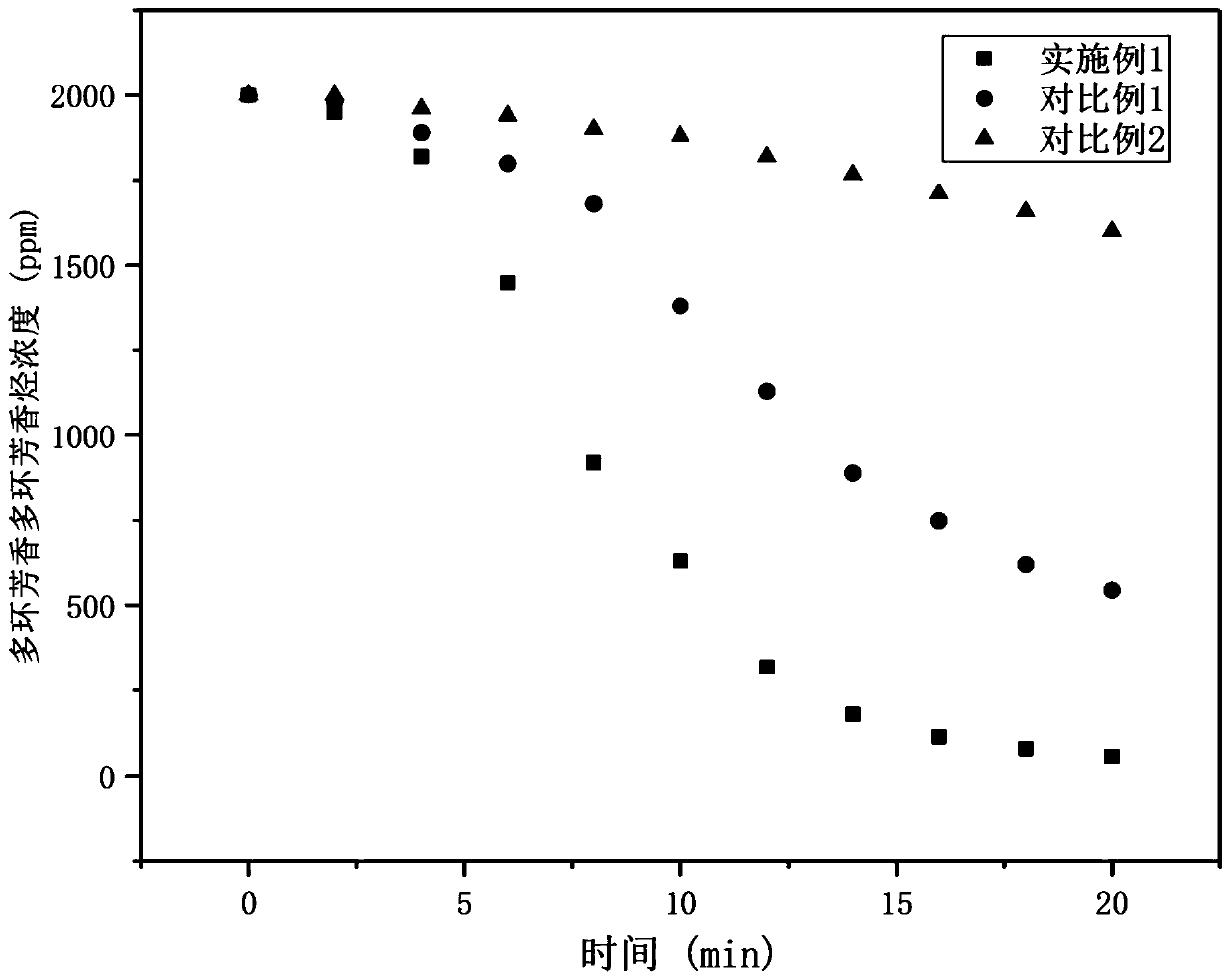Method for acetone intensified photodegradation on polycyclic aromatic hydrocarbons in wastewater
A polycyclic aromatic hydrocarbon, photodegradation technology, applied in chemical instruments and methods, special compound water treatment, light water/sewage treatment, etc. and other problems, to achieve the effect of improving the photocatalytic effect, good photosensitivity, and improving the decomposition efficiency.
- Summary
- Abstract
- Description
- Claims
- Application Information
AI Technical Summary
Problems solved by technology
Method used
Image
Examples
Embodiment 1
[0037] A method for acetone-enhanced photodegradation of polycyclic aromatic hydrocarbons in waste water, said method comprising the following steps:
[0038] (1) Micro-oxidation treatment: Introduce oxygen into the wastewater containing 2000ppm polycyclic aromatic hydrocarbons at a flow rate of 800mL / min for 2 hours to obtain oxygen-containing wastewater;
[0039] (2) Pretreatment solution preparation: add 1000ppm acetone to the oxygenated wastewater to obtain the pretreatment solution;
[0040] (3) Ultraviolet photocatalysis: Pass the pretreatment solution into a container with a multi-layer photocatalytic plate inside, and then irradiate with 254nm ultraviolet light for 20 minutes to obtain degraded wastewater with an irradiation intensity of 130uW / cm 2 .
[0041] The preparation method of the photocatalytic plate is as follows:
[0042] (S.1) Preparation of rare earth-containing airgel: Add tetraethoxysilane and rare earth powder to 150 parts of absolute ethanol at a mas...
Embodiment 2
[0047] A method for acetone-enhanced photodegradation of polycyclic aromatic hydrocarbons in waste water, said method comprising the following steps:
[0048] (1) Micro-oxidation treatment: Introduce oxygen into the wastewater containing 1000ppm polycyclic aromatic hydrocarbons at a flow rate of 500mL / min for 0.5h to obtain oxygen-containing wastewater;
[0049] (2) Pretreatment liquid preparation: add 300ppm acetone to the oxygenated wastewater to obtain the pretreatment liquid;
[0050] (3) Ultraviolet photocatalysis: Pass the pretreatment solution into a container with a multi-layer photocatalytic plate inside, and then irradiate it with 254nm ultraviolet light for 10 minutes to obtain degraded wastewater with an irradiation intensity of 120uW / cm 2 .
[0051] The preparation method of the photocatalytic plate is as follows:
[0052] (S.1) Preparation of rare earth-containing airgel: Add tetraethoxysilane and rare earth powder to 100 parts of absolute ethanol at a mass rat...
Embodiment 3
[0057] A method for acetone-enhanced photodegradation of polycyclic aromatic hydrocarbons in waste water, said method comprising the following steps:
[0058] (1) Micro-oxidation treatment: Introduce oxygen into the wastewater containing 3000ppm polycyclic aromatic hydrocarbons at a flow rate of 1500mL / min for 3 hours to obtain oxygen-containing wastewater;
[0059] (2) Pretreatment liquid preparation: add 1500ppm acetone to the oxygenated wastewater to obtain the pretreatment liquid;
[0060] (3) Ultraviolet photocatalysis: Pass the pretreatment liquid into a container with a multi-layer photocatalytic plate inside, and then irradiate with 254nm ultraviolet light for 30 minutes to obtain degraded wastewater with an irradiation intensity of 150uW / cm 2 .
[0061] The preparation method of the photocatalytic plate is as follows:
[0062] (S.1) Preparation of rare earth-containing airgel: Add tetraethoxysilane and rare earth powder to 200 parts of absolute ethanol at a mass rat...
PUM
| Property | Measurement | Unit |
|---|---|---|
| decomposition efficiency | aaaaa | aaaaa |
Abstract
Description
Claims
Application Information
 Login to View More
Login to View More - R&D
- Intellectual Property
- Life Sciences
- Materials
- Tech Scout
- Unparalleled Data Quality
- Higher Quality Content
- 60% Fewer Hallucinations
Browse by: Latest US Patents, China's latest patents, Technical Efficacy Thesaurus, Application Domain, Technology Topic, Popular Technical Reports.
© 2025 PatSnap. All rights reserved.Legal|Privacy policy|Modern Slavery Act Transparency Statement|Sitemap|About US| Contact US: help@patsnap.com

